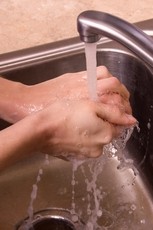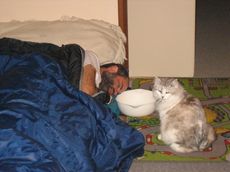Food poisoning can be caused by a number of different bacteria such as E-coli, Salmonella, Clostridium botulinum and several others.
The symptoms can range from:
…just to name the unpleasant ones.
Good vs Bad Bacteria
Bacteria are everywhere.
There is no way to completely eradicate all bacteria, and you shouldn’t want to anyway because some bacteria are actually good for you.
An example of good bacteria are the natural bacteria in yogurt (called Lactobacilli) which many women eat following a course of antibiotics so that these bacteria can help to restore balance in the intestinal tract.
Just because some bacteria are good for us, doesn’t mean that we should give up cleaning our homes or our kitchens though.
Sometimes people get food poisoning from eating food that was prepared in less than sanitary conditions, so it is always a good idea to keep your kitchen area clean.
Think You Have Food Poisoning?
The only way to know for sure if you have food poisoning is to go to the doctor for tests.
You can also take into account what you’ve eaten in the last few days, and if others who ate the same thing are sick as well. Many times, if more than one person is sick with the same symptoms and the same food was eaten, it’s a good indication that what you have is food poisoning.
Food Poisoning Treatment
If you think you have food poisoning, here are some things you can do to work towards getting better:
1. If you have severe symptoms such as uncontrolled diarrhea, vomiting, and or a high fever, you should see your doctor or go to the Emergency Room at your local hospital. There is one form of food poisoning that can be fatal if not treated in time called Botulism. The bacteria that cause this kind of food poisoning can kill you in a short period of time, so it’s nothing to play around with. Severe symptoms should always equal a trip to the doctor who will attempt to empty out your stomach and remove the toxin.
2. Drink as many fluids as you can keep down. When you are having diarrhea and vomiting it dehydrates your system quickly and you can become sicker if these fluids are not replaced. Replacing these fluids helps your body to flush the bad bacteria in your system.
3. Drink fluids that help to replace electrolytes. There are different drinks on the market now specially made to replace electrolytes which you lose when you have bouts of diarrhea and vomiting.
Electrolytes are salts and minerals that form electrically charges particles (ions) in body fluids. Electrolytes are important because they control body fluid balance and are important for all major body reactions. — Source
4. Don’t take an anti-diarrheal because while it may stop the diarrhea, it will keep the bacteria in your system longer. Vomiting and diarrhea are the body’s way of getting rid of the bacteria that are making you sick. While it is not a fun process to experience, and taking an anti-diarrheal may seem to make sense because it may make you feel better, in the long run you are not doing yourself any favors.
5. Rest as much as possible. Don’t try to go to work or school if you have food poisoning. While not contagious per se, your body will have a more difficult time fighting and getting rid of the foreign bacteria if you are stressing it by trying to work or go to class. Sleeping and resting as much as possible means you will feel better more quickly.
Things To Avoid
Following are some of the ways that bacteria can lead to foodborne illness.
It is in your best interest to avoid these things:
1. Eating undercooked meat.
If you cut into a piece of poultry and it is pink inside, return it if you are at a restaurant, and if you are at home throw it back in the oven to finish cooking before you eat it. Meat that is undercooked may have nasty bacteria lurking that can make you very sick if you consume the meat. Stay away from undercooked meat.
2. Eating foods that have been out for more than 2 hours.
Contrary to what your mother or grandmother may have told you, it is okay to put hot foods in the refrigerator. In fact, if you cook foods and then are not ready to eat them once they’re prepared, experts say you should just put them in the refrigerator in a shallow dish and then reheat them once you are ready to eat. This will avoid food poisoning.
3. Putting cooked foods onto the same dishes that raw meat rested on.
Believe it or not people do do this, and it is a recipe for disaster. When you have a plate that has had raw meat on it, immediately put it into a sink full of hot soapy water, or in the dishwasher so that you don’t accidentally re-use it.
4. Using the bathroom and then not washing your hands before eating.
This one is a no-brainer I think.
5. Handling raw meats and then not washing your hands before you eat.
Again you’d think this one was a no-brainer, but people do it.
6. Not keeping your kitchen clean.
Since you cook raw meats, vegetables and other foods in the kitchen and they come into contact with counters, stoves, and even cupboards, you should always clean up your kitchen following food preparation to prevent the growth of bacteria.
7. Not washing fruits and vegetables before eating them.
You should always wash fruits and vegetables before you eat them. Bacteria can thrive on the outside of fruits and vegetables. And let’s face it, you don’t know where they’ve been in between wherever they came from and the store you bought them at!
Nothing Prevents Food Poisoning Better Than Washing
Just these few good habits will help you to avoid food poisoning:
 Be smart, wash your hands with soap and hot water often — especially when you’ve been handling raw meats and even eggs or fruits and vegetables.
Be smart, wash your hands with soap and hot water often — especially when you’ve been handling raw meats and even eggs or fruits and vegetables.- Wash dishes that have had raw meat resting on them before using them again.
- Teach your kids about the importance of hand washing so that they can make it a habit.
Here is some interesting information (and a video) showing the proper handwashing procedure.




